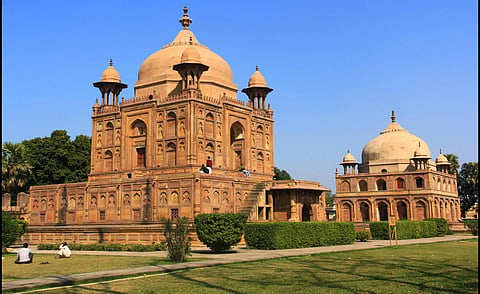
- Destinations
- Experiences
- Stay
- What's new
- Editor’s Picks
- Responsible Tourism
- CampaignsCampaigns
- Subscribe

Formerly known as Allahabad, Prayagraj is a historically significant place and one of the most populous cities in Uttar Pradesh. It stands at the confluence of the Ganga, Yamuna and Saraswati rivers and was a vital stronghold of the Mauryan and Gupta empires. The city played a crucial role in the Indian freedom movement and was also the birthplace of Jawaharlal Nehru, India’s first prime minister. Today, Prayagraj is famous for the Kumbh Mela, which attracts millions of pilgrims and visitors when it's held every 12 years.
Here are the seven of the best historical places to visit in Prayagraj.
The Allahabad Fort was constructed by the Mughal emperor Akbar in 1583 and is classified by the Archaeological Survey of India (ASI) as a monument of national importance. Within the fort, you will find the ancient Patalpuri Temple and the holy Akshaya Vat. The structure is a remarkable example of breathtaking Mughal architecture that showcases the craftsmanship of the era. Blending ancient and medieval history, the Allahabad Fort attracts visitors from far and wide to witness its historical lineage.
Khusro Bagh is another remarkable example of Mughal architecture. It houses three mausoleums—one for Prince Khusro, one for his sister and one for his mother. Each tomb is distinct but together they form a significant part of Mughal history. There is a lot of greenery here and the beautifully crafted tombs of Khusro Mirza and his family will surely catch your eye. Khusro Bagh offers a peaceful setting, making it a culturally rich and serene spot to visit.
The Anand Bhavan is a historic museum in Prayagraj that was the former residence of the Nehru family. It was bought by Indian political leader Motilal Nehru in the 1930s to live in but later became the local headquarters of the Indian National Congress. The place has since been turned into a museum and still preserves many of his personal belongings like furniture, books, clothing and photographs.
This museum was originally set up in 1863 by the governor-general of the northwest province, Sir William Muir, before being shut down for unspecified reasons in 1881. Afterwards, it was established under the aegis of the Allahabad Municipality in 1931. The Allahabad Museum has a rich and diversified collection of art, antiquities, paintings, sculptures, coins, ceramics, archaeological objects, illustrated manuscripts, decorative art objects, arms and armories, textiles, natural history specimens, photographs and prints. It also keeps personal collections of Mahatma Gandhi and Jawaharlal Nehru, as well as that of the city’s literary personalities like Sumitra Nandan Pant, Suryakant Tripathi "Nirala," Premchand and Mahadevi Verma. The building is located in the Civil Lines area in the lush green gardens of Chandrashekhar Azad Park.
This pillar is a remarkable example of ancient art and one of the most significant architectural pieces from the Mauryan dynasty. Later, inscriptions from the Gupta dynasty were also discovered on it, which further added to its historical value. The Allahabad Pillar is a rare and precious monument that everyone should visit to appreciate its significance and craftsmanship.
The sangam is a symbol of the rich cultural heritage and spiritual traditions of India. This sacred place is the confluence of three holy rivers: the Ganga, Yamuna and Saraswati. Millions of people come here to cleanse their sins and pray for blessings from Hindu deities. The massive Hindu gathering of the Kumbh Mela takes place on this spot.
This park was built in 1870 to mark Prince Alfred's visit to the city. With an area of 133 acres, it is the biggest park in Prayagraj and is named after freedom fighter Chandrashekhar Azad, who sacrificed his life during a gunfight with British forces. There is a colonial-era bandstand and other structures that reflect the park's British heritage that you can see there. The park serves as both a recreational space and a tribute to a national hero, making it an important part of Prayagraj's cultural and historical landscape.
